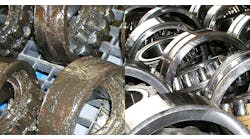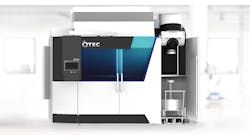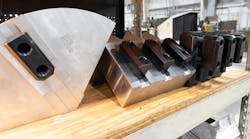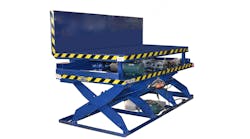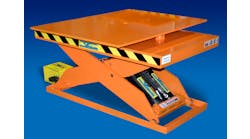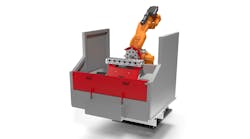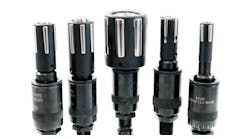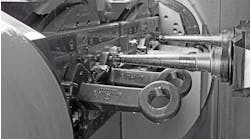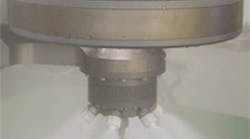Over the past 25 years there has been a drive to replace traditional graphite lubricants with synthetic products. Until recently, the use of synthetic lubricants was limited to simple components in order to prevent severe underfill, a high percentage of stickers, and uneconomically low die life.
More recently there have been numerous advances in synthetic formulations, making it possible for forgers to use them in production of more complex components. With this progression of synthetic technology, the industry is seeing a drive to convert from the traditional formulations to synthetic ones.
Why synthetic lubricants?
Synthetic lubricants offer sufficient advantages to forgers that make adopting them worthwhile, including:
• Stability in both concentrated and diluted forms, whereas even the best graphite lubricants will settle over time when diluted;
• The absence of any suspended solid particles makes dilution simple and does not result in nozzle clogging at the point of application; this can deliver higher productivity from reduced maintenance downtime;
• The concentration of diluted synthetic lubricant can be measured easily with a refractometer;
• Most synthetics leave a white coating when sprayed, making it easy to determine when the die surface is fully covered, and therefore reducing overspray;
• Cleaner forging environment;
• Synthetic lubricants are non-conducting, so they do not reduce the lifespan of electrical equipment like motors or control panels.
Generation 1 synthetic lubricants
The Generation 1 synthetics were simple products, purely a barrier between die and billet offering minimal release. They could only be used to forge the simplest shapes with limited metal movement. Early formulations left a hard deposit that combined with scale to form a hard build-up that prevented the dies from closing entirely, and giving a poor surface finish.
An initial improvement in synthetics occurred with the addition of ‘lift,’ where an explosive effect is generated between the forging and the die at fill, blowing the forging out of the die, and allowing use on deeper, lower draft dies.
These subsequent improvements concentrated on control of the hardness and adhesion of the residues to make the lubricants more user-friendly. However there remained no ‘lubrication.’ These products are best described as ‘parting agents’ that offer no real enhancement of metal movement. This inability to physically lubricate at the die-billet interface gave such severe reduction in die life that its use was uneconomical for complex forgings.
The early 1990s saw the introduction of boron nitride into some formulations. Boron nitride acts as graphite in the forging process, offering excellent sliding lubrication properties. While these formulations almost matched their graphite equivalents with the possibility to forge far more complex parts, including tooth gears in relatively deep dies with shallow draft angles, the raw material cost was —and remains — prohibitive. There is no commercial case for forgers to use synthetics based on boron nitride.
Synthetics evolved further into more advanced lubricants, improving performance in die wetting, part fill and lubrication. Lubricants such as P3® Forge 180 and P3® Forge 5300F were able to deliver a higher wetting temperature capability than other synthetics and are now used successfully for upsetting axles, forging pistons, and even some types of crankshafts. Other synthetics, such as Deltaforge® 1105, are used in precision forging of gears, illustrating how this technology can be applied to a wide variety of forging processes that are carefully matched to the lubricant capability.
Generation 2 synthetic lubricants
Within the last decade, the Generation 2 synthetic lubricants have evolved thanks to significant formulation improvements. Today a variety of complex and deeper forgings can be made without graphite.
These improvements have centered on three areas:
• Availability of new raw materials in combination with an increased investment in R&D due to the strong market drive for synthetics. Generation 2 formulations push the boundaries of film formation on hot dies and assist metal movement better than prior formulations.
• Developments in application technology improved spray patterns and droplet size control of the spray, and the momentum of droplets when they hit the die surface. The development of externally atomizing nozzles has allowed significant improvements. Figure 1 shows a tailor-made spray tool for forging difficult and complex circular components.
• Greater understanding of changes to the forging process required to use synthetics economically.
When substituting Generation 1 synthetics with the Generation 2 synthetics that contain improved formulations, some of the benefits experienced were improved die life, ability to forge complex shapes, and a reduction in build-up. Performance improvements have been seen across a wide range of press size and component s , a s s h o w n in Tables 1 and 2, when Henkel’s Deltabright® F-826S Generation 2 synthetic is introduced.
Table 2 additionally shows that careful selection of the lubricant is required, and that not all Generation 2 synthetics are suitable for all components, as the crankshaft example is comparing different Generation 2 products.
Generation 2 synthetic progress is illustrated by examples of medium-size and weight crankshafts forged graphite-free on transfer presses, with both precision and flood spray applications of the lubricant — although with process compromises and some higher costs having to be incurred by the forger to achieve this.
Process compromise requirements
While Generation 2 synthetics give opportunities to reduce the use of graphite, this sometimes comes at a cost. It is not always possible simply to remove graphite and introduce synthetics through the same systems, and to expect no changes other than a cleaner factory.
Number of steps. With more difficult forgings, e.g. crankshafts, the move to synthetic often makes it necessary to introduce an additional forging blow. The Japanese market has demonstrated a greater willingness to incorporate further reduction steps to facilitate the use of Generation 2 synthetics to such forgings.
Spray application. Improving application of lubricants through optimized use of modern spray equipment improves the performance of any forging process.
Graphite has a wider operating window for application – it’s a more forgiving product as superior lubricating properties compensate for inadequacies in application. Synthetic does not always protect the process in this way; to achieve good forging results a well optimized and efficient spray system is required.
Figure 2 shows the Henkel DAG® 2020L linear reciprocator that extends the operating window of synthetics through its control of consistently well-atomized spray, and its ability to be fitted with highly customized spray tools. Sophisticated spray application ensures a uniform coating deposit by precise and repeatable deposition of the lubricant onto the die cavity.
Die life. The best Generation 2 synthetics applied with the best modern spray equipment onto multiple- blow operations in a welloptimized process may not always achieve the same die life that a wellchosen graphite lubricant delivers in equally well-optimized circumstances.
No cur rent synthetic provides the physical lubricating properties and control over metal movement to the equal of graphite. However, it should be noted that some additional die wear and the costs associated with that may be necessary when changing to synthetic.
Eliminating graphite
The drive to eliminate graphite from forging operations is strong enough for the leading lubricant suppliers such as Henkel to continue to invest in synthetic development. In the last decade, significant improvements have been made that allow for heavier, more complex and demanding forgings to be made without graphite in a reasonably economic way.
Process and commercial compromises may be necessary in some cases to achieve a graphite-free process. These compromises, and associated costs, can be mitigated by working closely with the lubricant and spray-equipment supplier to take advantage of their experience of applying synthetics and ability to help optimize the process.
Synthetic development continues with a focus on controlling metal movement to deliver higher die life and the ability to forge more complex shapes in fewer steps. The goal is to develop a synthetic that delivers equal forging performance to graphite — such as Deltaforge® F-31.
Paul Spackman is the global marketing manager for the Metal Forming business unit of Henkel’s Metals division. Henkel develops and supplies both graphite-containing and synthetic forging lubricants, as well as spray equipment for lubricant application. Contact Spackman at +44 (0) 7768 356 696, or [email protected]


